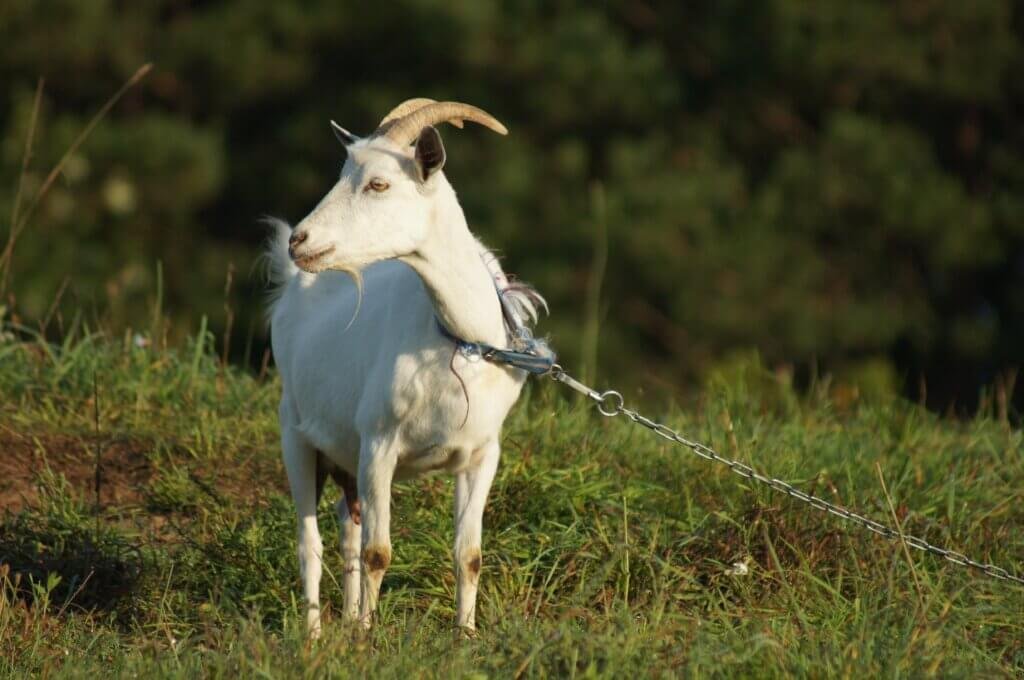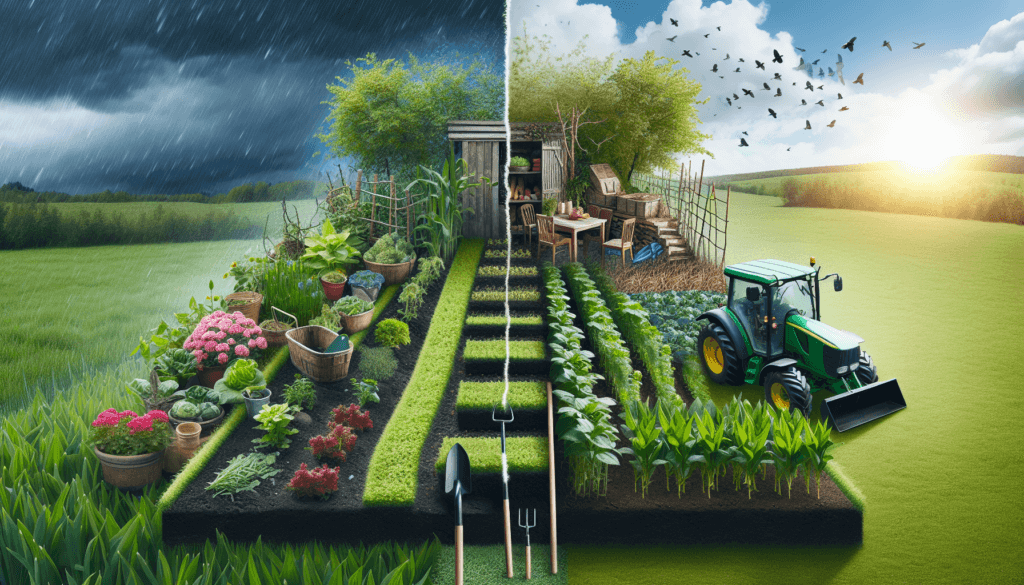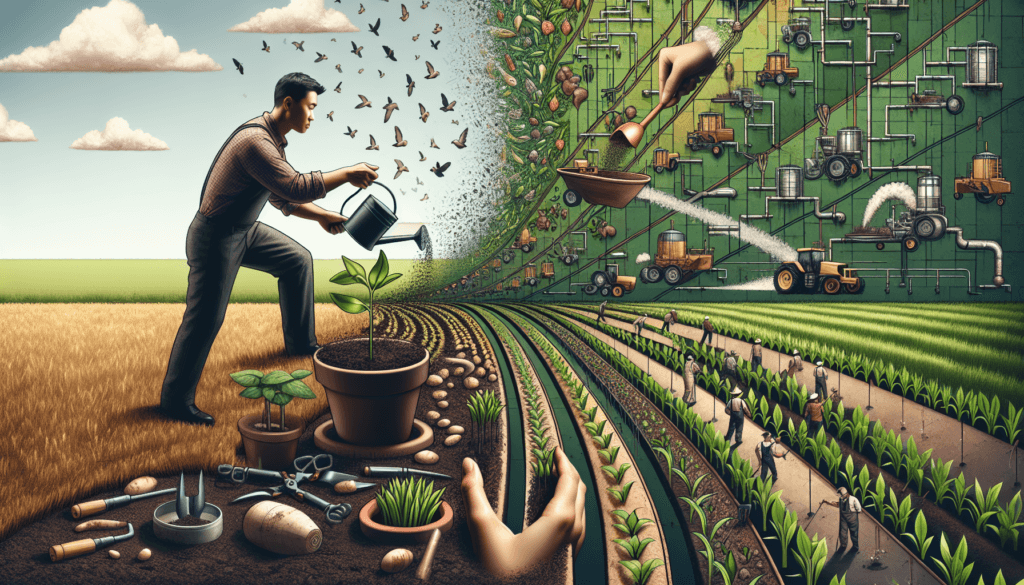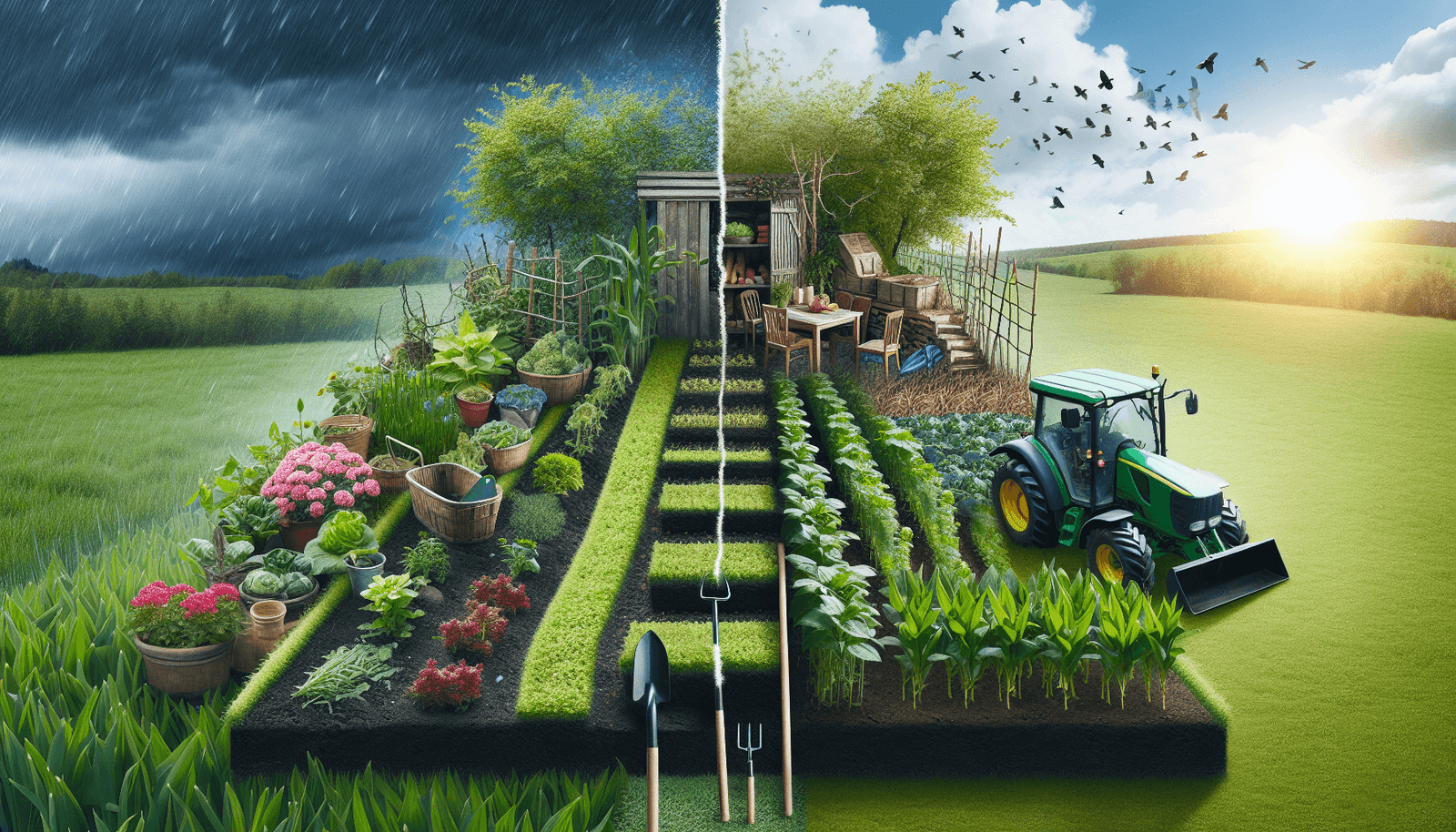Imagine this: you’ve spent countless hours tending to your plants, carefully planting seeds, watering, and nurturing them. As they grow, you find yourself with an abundant harvest of fruits and vegetables. But have you ever wondered at what point your gardening efforts transition into something more significant? At what point does gardening become farming? In this article, we explore the blurred lines and distinguishing factors that separate these two beloved practices. Get ready to delve into the world where green thumbs turn into industrious farmers.

Defining gardening and farming
Gardening and farming are two activities closely related to cultivating plants for various purposes. While they share similarities, there are distinct differences that set them apart. Gardening typically refers to the cultivation of plants on a smaller scale, often in one’s backyard or within limited spaces. It is often done for personal use, aesthetic purposes, or as a hobby. On the other hand, farming involves the cultivation of plants and the rearing of animals on a larger scale. It is usually carried out for commercial production, to meet the demands of the market, and to generate income.
Comparison of gardening and farming
Gardening and farming can be compared in terms of scale, intent, land usage, economic factors, labor and machinery requirements, specialization, environmental impact, food production, and regulatory distinctions. These aspects help distinguish the two activities from each other and provide a comprehensive understanding of gardening and farming.
The scale of gardening
Gardening is often characterized by its smaller scale. It is commonly practiced in residential areas, community gardens, and urban settings. The cultivated area in gardening is usually limited and may consist of containers, raised beds, or small plots of land. The focus is on growing a diverse range of plants, including flowers, ornamental plants, vegetables, herbs, and fruits, primarily for personal use or beautifying the surroundings. The scale of gardening allows individuals to have hands-on experience, experiment with different plants, and enjoy the benefits of homegrown produce.
The scale of farming
In contrast to gardening, farming operates on a larger scale. It may encompass vast agricultural lands that are specifically designated for crop production and livestock rearing. Farms are often established with the intention of meeting commercial demands and generating income. The cultivated area in farming can vary greatly, ranging from small family farms to large commercial operations. While farming focuses on crop production and livestock rearing, it also involves other activities such as processing, storage, packaging, and distribution to ensure the availability of products in the market.
Historical perspective
Origins of gardening
Even since early civilization, humans have practiced gardening. It can be traced back to the origins of agriculture and settlement, during the Neolithic period, when the first human societies transitioned from a nomadic way of life to settled communities. At this stage of human development, people began cultivating plants for food, which marked the birth of gardening. Early gardens were primarily focused on growing crops like wheat, barley, and legumes, resulting in the establishment of agricultural settlements that provided a stable food source.
Evolution of farming practices
As human societies advanced, so did farming practices. From relying on simple hand tools to utilizing animal-drawn plows and eventually transitioning to mechanized machinery, farming became increasingly efficient and productive. The utilization of irrigation systems, crop rotation techniques, and improved seed varieties further enhanced agricultural practices. These advancements helped meet the growing demands of burgeoning populations and cater to the needs of an expanding market.
Shift from gardening to farming
While gardening and farming have coexisted throughout history, there was a significant shift from gardening to farming as civilization progressed. As societies developed and populations grew, the need for increased food production arose. With farming’s ability to cultivate larger areas and cater to the demands of a growing population, it surpassed gardening in terms of scale and productivity. The specialization and efficiency found in farming made it the preferred method for sustaining communities and supplying food to wider regions.

Intent and purpose
Personal use vs. commercial production
One of the fundamental differences between gardening and farming lies in their intent and purpose. Gardening is predominantly carried out for personal use, satisfaction, and enjoyment. Individuals practicing gardening often derive pleasure from growing their own vegetables, cultivating beautiful flowers, or creating a serene outdoor space. It allows them to connect with nature, enhance the aesthetics of their surroundings, and experience the satisfaction of self-sufficiency.
In contrast, farming primarily focuses on commercial production and meeting the demands of the market. Farmers aim to generate income by producing crops and rearing livestock to be sold to consumers, wholesalers, or processed for various industries. Farming practices are driven by market trends, consumer preferences, and the need to ensure profitability. The intent of farming is to produce goods on a larger scale to sustain livelihoods and contribute to the global food supply.
Sustainability and self-sufficiency
Gardening often lends itself well to sustainable practices and self-sufficiency. With smaller cultivated areas and a focus on organic gardening methods, individuals can tailor their gardening practices to align with sustainable principles. This may include utilizing composting techniques, implementing water conservation methods, and avoiding synthetic pesticides and fertilizers.
Additionally, gardening allows individuals to become more self-sufficient, as they can grow their own food and reduce their reliance on commercially produced goods. By cultivating a diverse range of crops, individuals can enjoy a variety of fresh and nutritious produce while reducing their carbon footprint. Gardening reinforces the connection between humans and nature, promoting a sense of responsibility towards the environment and fostering sustainable lifestyles.
Farmers, on the other hand, face the challenge of balancing commercial production with sustainability. The larger scale of farming often requires the use of modern technologies and agricultural inputs to maximize yields. However, sustainable farming practices strive to minimize environmental impacts by reducing chemical usage, implementing efficient irrigation systems, and practicing soil conservation techniques. The aim is to meet commercial demands while preserving the long-term viability of agricultural lands and promoting environmental stewardship.
Land usage and cultivation
Size of the cultivated area
Gardening and farming differ significantly in terms of the size of the cultivated area. Gardening is typically practiced in smaller spaces, such as backyards, rooftop gardens, or community plots. The cultivated area in gardening can range from a few square feet to a few acres, depending on the available space and the individual’s preferences. The small scale of gardening allows for close personal attention to each plant, nurturing them individually to ensure optimal growth.
Farming, on the other hand, involves cultivating larger agricultural lands. The size of the cultivated area in farming varies greatly, ranging from a few acres to thousands of hectares. Farms are often specialized for specific crops or livestock, enabling farmers to focus on maximizing productivity and efficiency. The larger scale of farming requires the use of machinery, irrigation systems, and advanced cultivation techniques to manage and maintain the crops or livestock.
Crop selection and diversity
In gardening, individuals have the freedom to select a wide variety of crops based on personal preferences, climate suitability, and other factors. The diversity of crops in gardening allows for a mixed cultivation approach, including vegetables, fruits, herbs, and ornamental plants. Gardeners often experiment with different plant species and varieties to create a diverse and visually appealing garden. This diversity not only enhances the aesthetic appeal but also provides opportunities for biodiversity, attracting beneficial insects and wildlife.
Farming, on the other hand, may involve specialized crop selection based on market demand, profitability, and agricultural practices suitable for the specific region. Farmers tend to focus on specific crops or livestock that can be efficiently produced and sold in bulk. This specialization allows for economies of scale and streamlined agricultural practices, enabling farmers to meet the demands of the market effectively.
Intensive cultivation techniques
Intensive cultivation techniques are often employed in farming to maximize yields and efficiency. These techniques involve the use of machinery, advanced irrigation systems, and artificial fertilizers to optimize crop growth. In farming, the emphasis is placed on eliminating inefficiencies and maximizing productivity to meet commercial demands.
In contrast, gardening typically adopts more hands-on approaches, emphasizing organic and sustainable cultivation techniques. While some gardeners may choose to use fertilizers or compost, others rely on natural soil enrichment methods and avoid the use of synthetic chemicals. Gardeners often decompact and amend the soil manually, employ companion planting tactics, and practice regular crop rotation to promote healthier plant growth.

Economic factors
Market involvement and sales
Gardening is primarily a personal endeavor, and the produce from a garden is often used for personal consumption or shared with family and friends. While some gardeners may have surplus produce to sell at local markets or through direct sales, the commercial aspect of gardening is usually limited. Gardeners who sell their surplus produce may do so on a small scale as a way to generate some additional income, but the main focus remains on personal use and enjoyment.
Farming, on the other hand, is inherently focused on commercial production and meeting market demands. Farmers aim to produce crops or raise livestock, which can be sold to wholesalers, retailers, processors, or directly to consumers. The involvement in the market is a fundamental aspect of farming, and farmers often rely on stable market conditions and consumer preferences to sustain their livelihoods.
Income generation and livelihood
Farming can provide a significant source of income for individuals and families involved in the industry. The commercial aspect of farming allows farmers to generate revenue through the sale of crops, livestock, and related products. However, the income generated from farming can vary depending on factors such as the size of the farm, the types of crops or livestock raised, market conditions, and production efficiency.
Although gardening is primarily practiced for personal use and enjoyment, it can also contribute to income generation on a smaller scale. Some gardeners may choose to sell their surplus produce, flowers, or plants at local farmers’ markets, roadside stands, or through community-supported agriculture programs. While the income generated from gardening may not be as substantial as in farming, it can provide a supplemental source of income and contribute to the local economy.
Labor and machinery
Mechanization and automation in farming
Farming has witnessed significant advancements in terms of mechanization and automation. Modern agricultural machinery and equipment have revolutionized the farming industry, increasing efficiency and reducing labor requirements. Various machines such as tractors, combines, seeders, and harvesters have made farming processes more streamlined and less labor-intensive. This has allowed farmers to manage larger areas of agricultural land and undertake tasks more efficiently.
Automation technologies have also been introduced in farming practices, such as sensor-based irrigation systems, robotic milking machines, and automated feeding systems for livestock. These innovations minimize manual labor, improve productivity, and enhance overall farming operations.
Labor requirements in gardening
Gardening typically requires more manual labor compared to farming, as it often involves hands-on care and attention to individual plants. Gardeners spend time nurturing plants, tending to their specific needs, pruning, and planting. The small scale of gardening allows for greater personal involvement, with gardeners often engaging in tasks such as weeding, watering, and harvesting.
While the labor requirements in gardening may be more time-consuming compared to farming, many individuals view the physical work as a rewarding and therapeutic activity. Gardening can provide an opportunity for relaxation, exercise, and a sense of accomplishment as the fruits of one’s labor grow and flourish.

Specialization and expertise
Knowledge and skills in agriculture
Farming requires specialized knowledge and skills related to crop production, livestock rearing, disease control, and agricultural practices. Farmers often have a deep understanding of soil conditions, weather patterns, pest management, and market dynamics. They apply scientific principles, engage in continuous learning, and adapt their practices to stay abreast of new developments in agriculture. The expertise required in farming encompasses a wide range of disciplines, from agronomy and animal husbandry to business management and marketing.
Gardening, while less specialized than farming, still requires a certain level of knowledge and skill. Gardeners need to understand plant biology, soil composition, crop rotation techniques, and pest management to ensure healthy plant growth. However, the knowledge required for gardening is often more accessible and can be acquired through various resources such as books, online platforms, and gardening communities.
Gardening as a hobby or leisure activity
One element that distinguishes gardening from farming is the aspect of personal enjoyment and leisure. Gardening is often pursued as a hobby, a form of relaxation, or a way to connect with nature. Individuals engage in gardening to create aesthetically pleasing landscapes, cultivate unique plants, and experience the satisfaction of nurturing life from seed to harvest. The hands-on involvement in gardening provides a therapeutic escape from daily stresses for many people, allowing them to find solace and joy in nature.
People often incorporate gardening into their lifestyles to reap the mental and physical health benefits associated with spending time outdoors and working with plants. Whether it’s a small container garden or a larger backyard plot, gardening offers a creative outlet and an opportunity to take pride in the beauty and productivity of one’s surroundings.
Environmental impact
Ecological considerations in farming
Farming practices can have significant environmental impacts, including habitat loss, soil degradation, water pollution, and greenhouse gas emissions. Large-scale agricultural operations often rely on agrochemicals, such as pesticides and fertilizers, which can have adverse effects on ecosystems and human health if not managed properly. Additionally, the use of heavy machinery in farming contributes to carbon emissions and energy consumption.
To mitigate these impacts, sustainable farming practices have gained prominence in recent years. These practices prioritize soil conservation, water management, biodiversity protection, and reduced chemical usage. Farmers are encouraged to adopt techniques like crop rotation, cover cropping, integrated pest management, and precision agriculture to minimize their ecological footprint. By implementing sustainable practices, farmers can contribute to the preservation of natural resources and the enhancement of biodiversity.
Localized impact and biodiversity
Gardening, particularly when focused on native plants and pollinator-friendly practices, can have a positive impact on local biodiversity. By cultivating a diverse range of plants, gardeners provide food and habitat for a variety of insects, birds, and other organisms. Gardens can act as miniature ecosystems, promoting pollination, attracting beneficial insects, and even contributing to the conservation of endangered plant species.
The scale of gardening, often practiced in residential areas or community gardens, allows for the creation of localized pockets of biodiversity. Gardeners can take advantage of their smaller cultivated areas to include native plant species, create wildlife-friendly habitats, and join efforts to protect local flora and fauna. Through gardening, individuals have the opportunity to actively contribute to the preservation of biodiversity and the restoration of natural habitats.

Food production and supply
Contribution to food security
While gardening primarily serves personal needs, it can still contribute to local food security. By growing a portion of one’s own food, gardeners can reduce their reliance on commercially grown produce and contribute to their household’s nutritional needs. This self-sufficiency also provides a sense of security in times of economic uncertainty or disruptions in the food supply chain.
Farming, however, plays a crucial role in global and regional food production. Large-scale agricultural operations are responsible for the majority of the world’s food supply. Farms utilize advanced cultivation techniques, machinery, and genetic improvement to meet the demands of growing populations. They often have the capacity for mass production, ensuring a consistent supply of food to markets and communities. Farming provides the scale necessary to feed a rapidly growing global population and safeguard food security.
Distribution channels and accessibility
The distribution of produce from gardens and farms differs in terms of reach and accessibility. Gardeners typically have limited distribution channels, often sharing surplus produce with friends, family, or neighbors. Some gardeners may participate in farmers’ markets or community-supported agriculture programs to sell their surplus, but these outlets are usually localized and serve a smaller customer base.
Farming, on the other hand, operates on a larger scale, with produce distributed through various channels. Farmers have greater access to wholesale markets, supermarkets, restaurants, and other retail platforms. These distribution channels enable farmers to reach a wider consumer base and ensure the accessibility of their products to a larger population. As a result, farming plays a vital role in supplying food to urban areas, where access to fresh and locally produced food may otherwise be limited.
Regulatory distinctions
Government regulations and certifications
Both gardening and farming are subject to government regulations and certifications to ensure food safety, environmental protection, and fair trade practices. Governments may have specific guidelines and standards for agricultural practices, pesticide usage, organic certification, and animal welfare. These regulations aim to safeguard public health, protect the environment, and maintain consumer confidence in the food system.
Farms, especially those involved in commercial production, are often subject to more stringent regulations due to the scale of their operations and their impact on the wider community. Compliance with these regulations may involve obtaining licenses, adhering to specific labeling requirements, and undergoing inspections to ensure compliance with food safety standards.
While gardening may not be subject to the same level of regulations as farming, individuals practicing gardening are still encouraged to adhere to good gardening practices and comply with local laws and guidelines. This may include proper waste management, responsible pesticide usage, and following recommended practices for safe and healthy food production.
Legal definitions of gardening and farming
The legal definitions of gardening and farming may vary depending on different jurisdictions. However, the distinguishing factors between the two activities typically revolve around the scale and commercial intent. Gardening is often defined as the practice of cultivating plants for personal use or recreational purposes on a smaller, non-commercial scale. Farming, on the other hand, refers to the business of cultivating plants and rearing animals on a larger, commercial scale for the purpose of selling agricultural products in the market.
The legal definitions may influence various aspects, such as zoning regulations, tax implications, and eligibility for agricultural subsidies. Understanding the legal distinctions can help ensure compliance with regulations, access to resources, and the ability to participate in specific agricultural programs or initiatives.
In conclusion, while gardening and farming share common elements of plant cultivation, they differ in scale, intent, land usage, economic factors, labor requirements, specialization, environmental impact, and regulatory considerations. Gardening provides individuals with a personal and enjoyable connection to nature, producing small-scale, self-sufficient harvests. In contrast, farming caters to commercial demands, contributes to food security, and requires greater expertise and resources. Both activities have their place in society, catering to personal needs, sustaining livelihoods, and shaping the global food production landscape.


